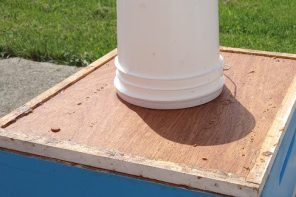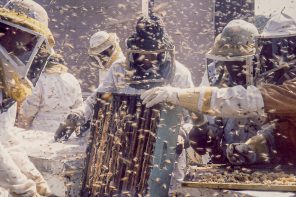I’ve been having the most remarkable conversations with very good honey tasters. I’ve been lucky with finding honey tasters lately.
It started with Marina Marchese, who came to visit our Medina Beekeepers last week. She’s one of the best known honey tasters…or sommelier as true tasters like to be called. Marina wrote a book a bit ago…The Accidental Beekeeper…she wanted to write about honey tasting but her publisher got blown away by the fact that this very feminine, attractive young lady actually was a beekeeper. So they said…OK, you can talk about honey, but first, you have to tell us about how you became a beekeeper. So being a wise lady she did…and the little bit about honey tasting is in the back. Once discovered, you’ll see that she’s a natural when it comes to talking about tastes like citrus, spicy, dry, moldy, toffee, apple, mint, cloves, or raw bean. She has it down when it comes to describing the hundreds of tastes you’ll find when tasting all the honeys you can find. In her spare time she is the President of The Backyard Beekeepers, a dynamic group in Connecticut, and runs her own business Red Bee Honey, selling lotions and potions and such. She’s busy.
Her honey tasting events aren’t just tastings though. She uses pairings…this kind of honey with apples, that kind of honey with strong cheese, another with dried apricots, still another with walnuts….ohhh, the tastes you’ll taste when Marina comes to town.
But wait, there’s more. Imagine which wine orange blossom honey goes best with…or starthistle, or clover, or basswood. Oh my…you can’t imagine what happens when you have an exotic mix of flavors rolling around on your tongue. It is unique beyond your experience.
OK, Marina’s good. Very, very good. And getting better every day. But I recently found out there was somebody that might be better.
Meet Leonard Kurtz. Here’s a master. Leonard has worked for Sue Bee Honey for 50 years. 50 years! For a lot of that time he was the taster, the guy who confirmed that yup, that’s clover, that’s alfalfa, that’s basswood, that’s starthistle, that’s soybean, or better, that’s a clover/alfalfa blend, or maybe that’s mostly goldenrod, but there’s some aster and thistle in there too, or there’s some clover in there, but it’s really mostly tallow. He could tell in a half second. And pretty much still can, even though he’s been away from it for awhile. But then, so can a lot of beekeepers who’ve been around, and I’ll bet a lot of honey packers can too. I kind of can…certainly starthistle is outstanding, and basswood if it’s mostly basswood, alfalfa…sometimes, and clover is clover, right?
Well, I thought clover was clover until I talked to Leonard. Now I’ve known Leonard for maybe 20 years. He visits the Root Company once a year to talk to our candle people about beeswax because we purchase a lot of the stuff from his company…it’s consistently clean, the right color and priced right for what we do. But when he’s done talking to the candle folks, he almost always stays on for lunch with me. When John Root was still here the three of us would go and talk bees for an hour over a burger and fries. Leonard had the scoop on what the national honey and wax scene was, and he always had stories on what his bees were doing and questions to us on what else was going on in the industry. It was a good time.
This year we were both at the Iowa State Beekeeper’s meeting and got to talking about tasting honey, and he shared some of his experiences from his time doing that…I hadn’t realized he was in the honey part of the operation…to me he’d always been on the wax side. Well, he was telling me he, and others at the plant could tell the difference between white sweet clover honey from South Dakota, Montana and Idaho…really. Maybe it’s the soil, he said, or maybe each place had something different blooming at the same time that altered the flavor just a tiny bit…enough to make it identifiable. Whatever it was, he could tell.
But wait, there’s still more. Not only can Leonard tell you what kind of honey he’s tasting, or what the blend is in the bottle…he can tell you, within a half point, what the moisture content is just by the way it feels. Really!
Now that’s a skill I’ll probably never attain. I’d like to try though. So I’m going to do some tests…make some changes to honey I have…add a little water…just a tiny bit…to see if I can tell. We’ll see.
Meanwhile, if you want to know more about varietal, or artisan honeys, check our Marina’s book The Accidental Beekeeper, or mine on the same subject, The Honey Handbook. I’ll bet you’ve got a lot to learn.









Nice article. Here in Ontario where the Niagara Peninsula fist starts, I’ve been doing the same for almost 15 years and have a tasting room with a tasting bar similar to a winery, with all the varietals on tap so to speak. My clientele is from miles around and enjoy a tasting from July to September -allowing them to choose which one they will go home with. What is most fascinating is the person’s own description of what they are tasting since everyone’s palate is different. I extract each super separately, noting on the pail -the yard, hive number, when it came off and moisture along with weight. Like a winemaker, the bees are the masters and wow us with their craft.